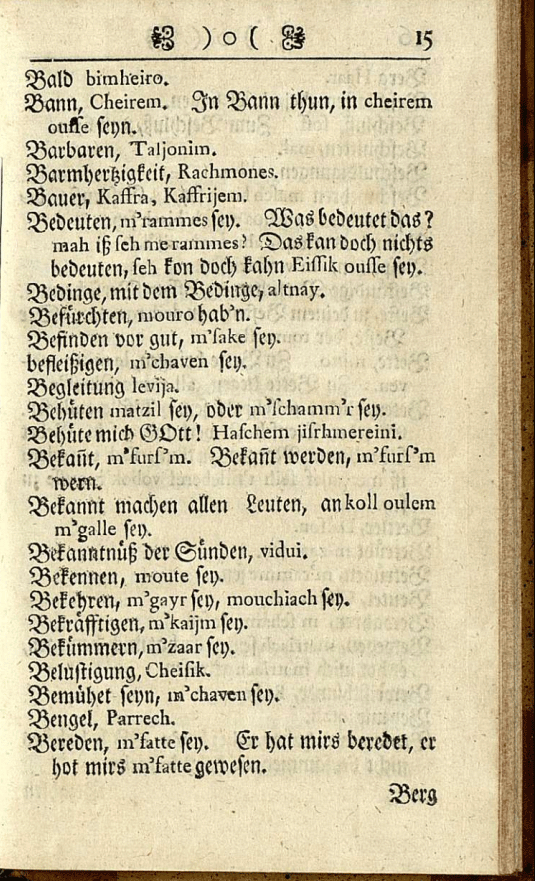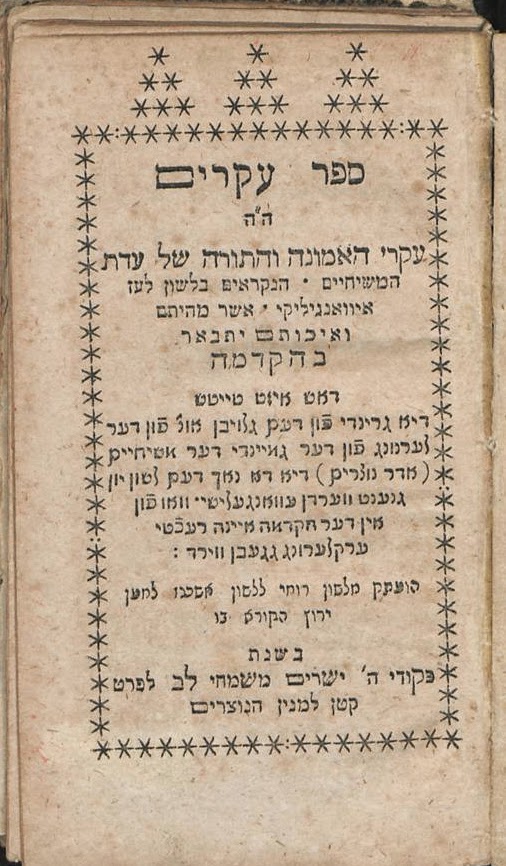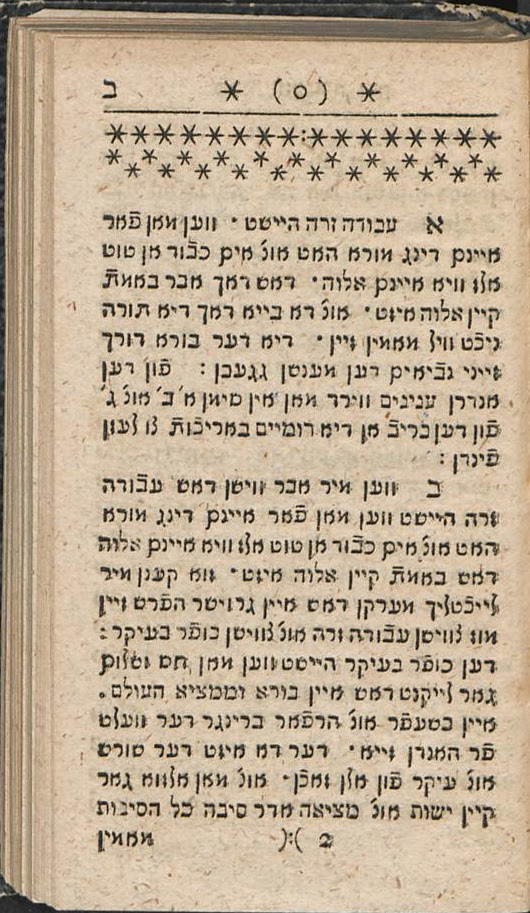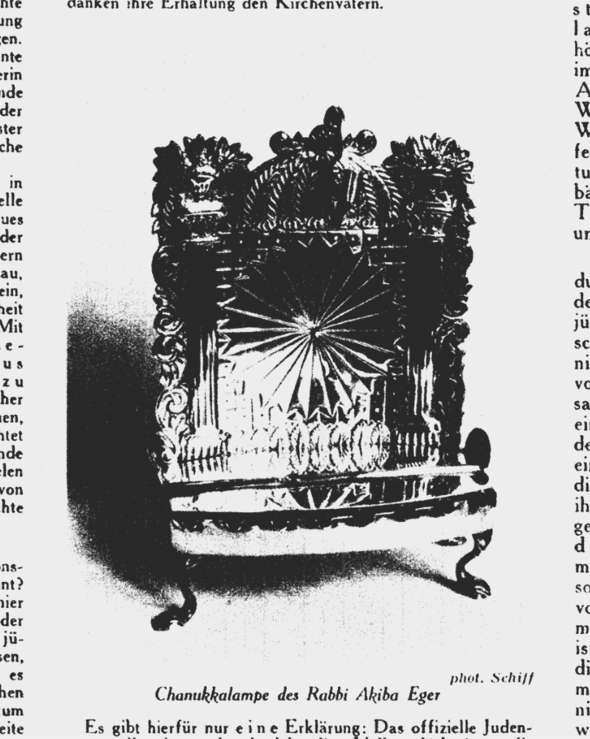Thursday, December 30, 2010
For whom does Moses Mendelssoh speak? On banning the ban.
Tuesday, December 28, 2010
The real first dictionary of Yeshivish from 1733; on 18th century attempts to Evangelize the Jews in their own language and cultural forms.
Friday, December 24, 2010
The first dictionary of Yeshivish from 1736.
As you can see, the Hebrew text is printed using Wayberteitch, or the special Yiddish font which survived until well into the 19th century. Thus, the text presupposes that the reader not only has a basic reading knowledge of Hebrew but already knows how to read the Wayberteitch font - which anyone who is familiar with the Rabbinic or Rashi script can read with some practice.
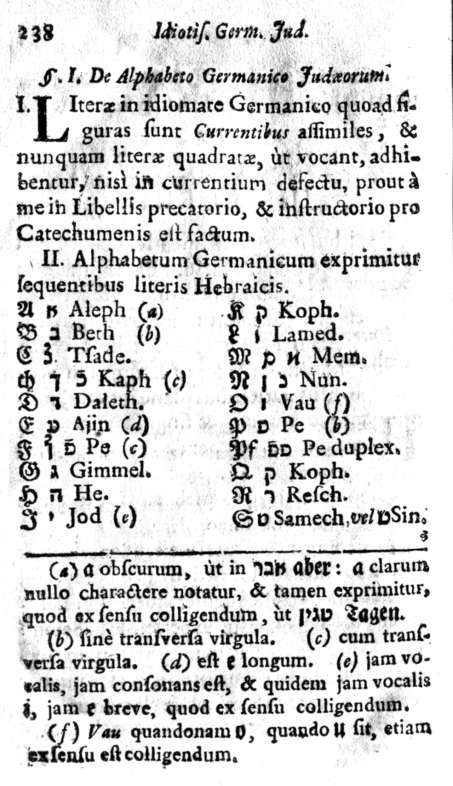
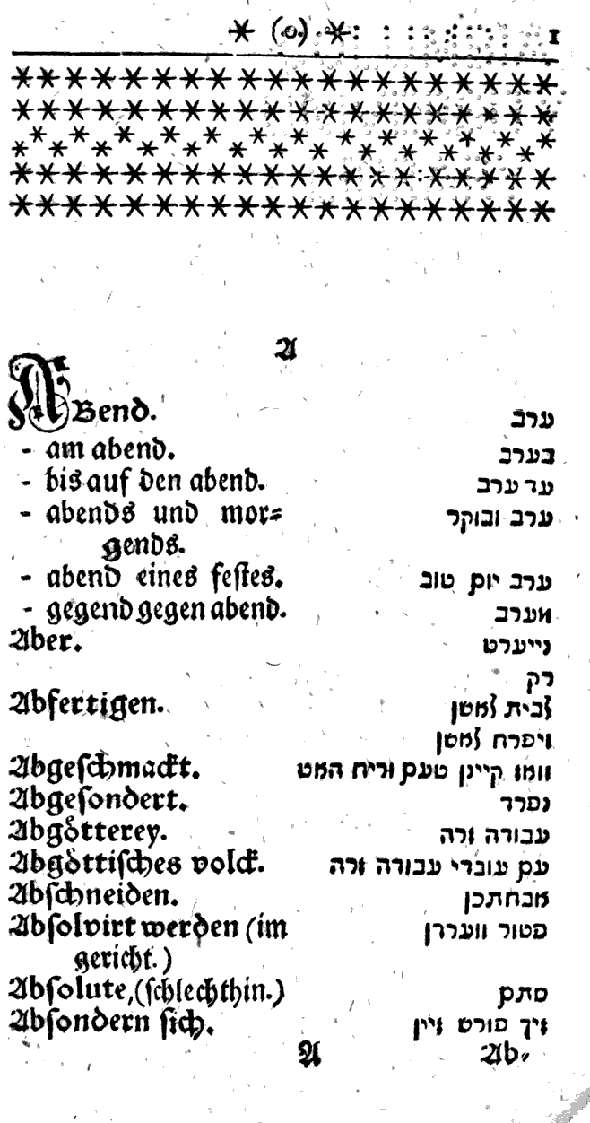
Monday, December 20, 2010
The prayer service of Rabbi Nosson Adler's rebbe Rabbi David Tevele Schiff, printed in London 1793.
These services were "composed in Hebrew" by the rabbi The Rev. David Solomon Shiff, "High Priest of the Said Synagogue," otherwise known as David Tevele Schiff (or רבי דוד טעבלי כ"ץ שיף). Rabbi Schiff (1715?-1791) was the Chief Rabbi of the Ashkenazim (although this was not an official position yet) from 1765 until his death.
As an aside, some have wondered at the oddity of early British Chief Rabbis styled as "High Priest" of the Jews by the British press. I wonder if this tradition (carried on most especially through his eventual successor, Rabbi Solomon Hirschell) was not in some way due to the fact that Schiff was a kohen. Sometimes in overly flowery rabbinic salutations a kohen might be addressed as a כהן הגדול, lit. "Great Priest," but very similar in construct to the original Hebrew for "High Priest," כהן גדול. Maybe some such letter was seen and gave birth to this quasi title. Or, perhaps the mere fact that he was a kohen and was the rabbi, or head, of the congregation is what gave rise to it.
Rabbi Schiff had a distinguished rabbinic career on the continent, holding respected positions in Worms andFrankfurt A.M. Here is how he (and his wife) were listed in the Worms Memorial Book (printed in Kobetz al Yad v.3):
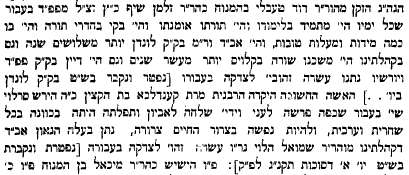
His most famous student is undoubtedly Rabbi Nosson Adler, one of the primary teachers of the Chasam Sofer. In the introduction to Mishnas Rabbi Nathan he is described as one of Rabbi Adler's three rabbis, alongside the author of Penei Yehoshua (who was a rebbe of Schiff as well) and Rabbi Moshe Rapp. However, only Rabbi Schiff is called his רבו מובהק. Both rabbi and student published nothing in their lifetime. However, each of them had a great work recording their teachings published posthumously. Rabbi Schiff's לשון זהב was published in 1822, and Rabbi Adler's משנת רבי נתן was published in 1862. Rabbi Markus Horovitz showed, in volume 4 pg. 39 of Frankfurter Rabbinen, that many explanations in Mishnas Rabbi Nathan are the same as in Leshon Zahav, suggesting that Rabbi Nosson Adler faithfully taught Torah which he received from his rebbe. [1]
This prayer service begins with the sifrei Torah being brought into the synagogue from a side room, under a canopy. While they are brought in, the people are to say ברוך הבא בשם ה. The Torahs are deposited into the aron. Prior to mincha, the chazzan is instructed to recite a special piyut composed by Rabbi Schiff. The piyut forms two acrostics woven together. One consists of verses beginning with the letters which spell out דוד טעבלי ברבי שלמה זלמן כהן, and the other is the order of the אלפא ביתא. Although you can see the entire piyut in the Scribd document, I will include one line right here, because it is interesting. It reads במדינה זאת הקים אדונינו המלך שארש השלישי על שכמו המשרה/ As in this country, where George the Third sways the sceptre (as translated by Levi, who notes that the Hebrew is "the government is on his shoulders"). Thus, Rabbi Schiff transliterated George as שארש in Hebrew.
After the reading of this poem, the Torahs are brought out and a series of seven hakafos, circuitous processions were to take place, while seven especially chosen psalms are recited. Afterward, the Torahs are returned to the aron. Then another piyut was to be recited, this one also written by Rabbi Schiff, but recycled from its use in the dedication of the Great Synagogue in 1766 (that time Handel's "Coronation Anthem" was performed, and Rabbi Schiff recited prayers in English - which he never mastered, although more on that below). In 1766 this prayer was printed in Amsterdam as a special broadside:
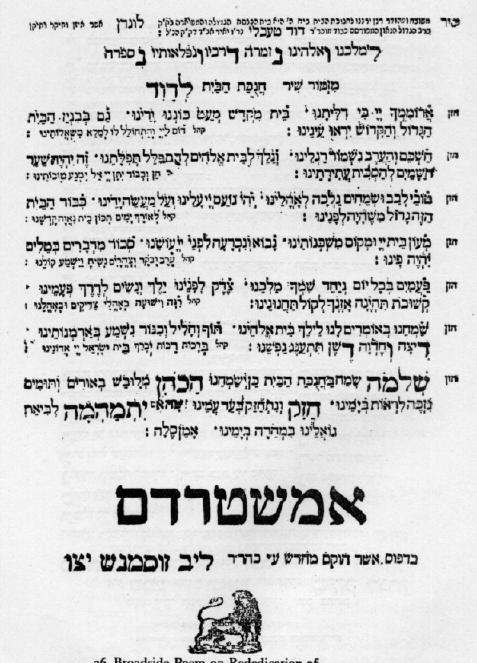
Afterward, a special poem was to be recited in honor of the woman responsible for it all, Judith Levy, who had provided the most money for the construction. The poem is an acrostic of her name, יטה בת משה זל - the service gives no indication who wrote it, but presumably it was Schiff.
Then, three sifrei Torah were to be removed from the aron, and the Chazzan, while holding one Torah, with two others on his right and left, is to intone the הנותן תשועה למלכים prayer for governments. As it is printed, it appears that while the prayer was said in Hebrew, the English phrases "Our sovereign Lord King George the Third" and "Our most gracious Queen Charlotte," etc. were recited in English.
After the prayer for the King and Queen, a Mi Sheberach was to be recited in honor of Judith Levy, where the sum of her donation was read - בעבור שנדבה ארבעה אלפים ליטרות שטערלינ לבנין בית הכנסת הזה - four thousand pounds, which was a gazillion dollars in those days. Finally, the three seforim were to be returned to the aron and the Chazzan and his choir were to sing the joyous and musical Psalm 150 with mincha, and probably Kabbalat Shabbat following.
Thus, the road to Pressburg (i.e., the Chasam Sofer's שלשלת הקבלה) did begin, in part, through a Reverend High Priest who composed a unique prayer service for the dedication of his synagogue.
Since he was a rabbi in London for almost 27 years - the Worms yizkor book is mistaken in writing that it was 30 years - what of Rabbi Schiff's English? As I mentioned before, when the Great Synagogue was enlarged and rededicated in 1766, Rabbi Schiff recited a prayer in English - but that could have been coached and memorized. The truth is that at the beginning of his career in London, and probably at the end too, the vast majority of congregants probably conversed among themselves in Western Yiddish. The first time it occurred to this congregation to require its rabbi to know English was as late as 1842, when it embarked on a search for a successor to Rabbi Solomon Hirschell. One of the conditions was that whomever was elected would learn to speak English withing one year - as it happens, Rabbi David Tevele Schiff's sister's grandson was appointed, another rabbi named Nathan Adler. Although I'm sure it would have required its Chief Rabbi to speak English 10 years earlier too, and probably also 20 years earlier - it is a fact that when Rabbi Solomon became Chief Rabbi 40 years earlier no one thought that acquiring English was necessary (although he of course did acquire at least some English).
Thus it does not seem that in the 1760s, and possibly as late as 1790, there was any special reason for Rabbi Schiff to have bothered learning English. However, you can't live for decades in a country without picking up some of the language anyway. A few interesting personal letters of his were published by Charles Duschinsky, most to his brother. Naturally they are written in an admixture of rabbinic Hebrew and Western Yiddish. Duschinsky points out that in a few places he uses English words (e.g., פאוועראבל for "favourable" or פארטיקלאר, "particular"). With regards to his skill in English, Duschinsky points out that David Levi "had to" translate the pamphlet highlighted in this post to English but I don't think we can use this as proof one way or another. Although I agree that he probably did not have a good English, even if he spoke a decent English that would not make him capable of translating Hebrew poems - even composed by himself - into English. Furthermore, that's not the sort of task one would expect of a learned rabbi of the time, and the title page said that David Levi was commissioned to translate it by the order of the lay leadership of the shul. Even were Schiff perfectly capable of translating or composing in English, one would expect someone else to do the translation.
Finally, some time ago I posted about an 18th century responsum from Holland which mentions a donation by famous Colonial Jewish-American Haym Solomon (link). In the comments the question was raised, how can we be certain that the "famous donor Chaim of Philadelphia" was Haym Solomon? It turns out the proof was published more than 70 years ago in an article when a 1784 correspondence between Haym Solomon and Rabbi Schiff was printed in the AJHS journal by Hyman B. Grinstein, titled "A Haym Salomon Letter to Rabbi David Tevele Schiff, London, 1784." In this fine Hebrew and Yiddish letter Solomon, addressing Rabbi Schiff as ידיד בכל דרכי' משכיל, mentions sending money to the same Gumpel Wolfenbuttel to whom the responsum in my prior post was addressed. Here too Solomon mentions giving money to him. In short, he was Haym Salomon's go-to guy in Europe. Thus, there is no doubt that it is the famous Haym Solomon mentioned in the responsum in the Pene Aryeh (the author of PA was a contender for Chief Rabbi of London after R. Schiff died, which gives you an idea of how intertwined the rabbinic elite were in those times).
The letter was not written by Solomon himself, as apparently his education did not enable him to compose a Hebrew letter. However, on the theme of Englishisms, the letter is headed with the following: קאפּי מן ז' אלול, that is Copy [of the original letter] made on 7 Elul [1784].
Here is Rabbi David Tevele Schiff's portrait:
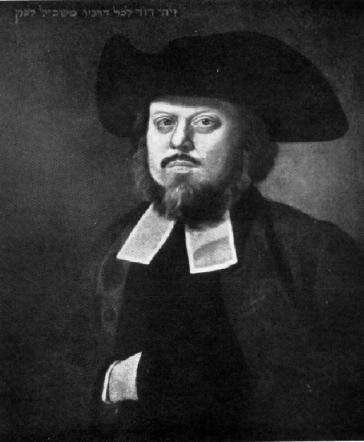
[1] It occurs to me that something may be worth investigating. As is well known, Rabbi Nosson Adler maintained the unique practice - or non-practice - of not writing down his Torah thoughts. The reason he gave for this was his prodigious memory. He felt that since he did not forget any of his Torah thoughts that the dispensation to write Torah she-be-al peh did not apply to him. How then do we know what he taught? Not from his writings, but from his students. How did it come about that the publisher of Mishnas Rabbi Nathan had a Mishnah commentary of Rabbi Nosson Adler to publish? The publisher, Rabbi B.H. Auerbach's, father was a student of Rabbi Adler. Thus, according to Rabbi Auerbach, these teachings of Rabbi Nathan Adler were taught to him by his father.
Now, I am definitely not accusing Rabbi Auerbach of manufacturing this, but since he has already been indicted (if not convicted) as a literary forger (link) one might say that the Mishnas Rabbi Nathan is in need of authentication, and one wonders if the way to authenticate it is not to note that many of the teachings are the same as those in Leshon Zahav, by his rebbe, which Auerbach could have seen, but if some of these teachings are also found among other students of Rabbi Adler. The Chasam Sofer famously maintained that he only taught that which he received from his teachers. Putting aside whether or not this was an exaggeration, are parallels to Mishnas Rabbi Nathan to be found in his writings? What about those of other students of Rabbi Adler? - living students, whom I may add, were probably in short supply in 1862, if any were still alive at all (Rabbi Nosson died in 1800). In short, since Rabbi Auerbach unfortunately is not above suspicion, and since a brilliant forger could well have decided to base some of it on the verifiable teachings of Rabbi Adler's rebbe, it would be interesting to see if these teachings have been, or could be, confirmed through the writings of other students of Rabbi Adler. Of course these could also be a source for such a forgery so long as they were published prior to 1862, but at least we might have further independent confirmation of what Rabbi Adler's teachings were.
UPDATE: In the comments a reader points out that the primary accuser of Rabbi Auerbach as a forger already accused him of forging Mishnas Rabbi Nosson as well - almost exactly 100 years ago.
Monday, December 13, 2010
Vilna Girl Believes She is Possessed by a Dybbuk; JTA 2/18/1929
Dateline: Vilna
The scenes of S. Ansky's play, "The Dybbuk," which was presented last year in leading cities throughout the world, being played in New York in Yiddish, English and Hebrew, were enacted in real life here when a Jewish girl in the city declared she was possessed of a Dybbuk (evil spirit) which was torturing her to death.
The rabbis decided to cast out the dybbuk by pronouncing a Cherem (religious ban) against it. The girl objected, however, to the ceremony connected with casting out the dybbuk, declaring that the black candles, the white cloaks of the rabbis and the blowing of the Shofar would terrify her.
The rabbis decided to write the Cherem on parchment, to dip the written document in water and to give the solution to the girl to drink. In order that she might not be harmed by the dissolved ink, fruit juice was used to write the Cherem.
Vilna Jews are awaiting the results.
Hebrew odes to Vampires and pretentious wearers of two pairs of tefillin from the 1850s.
Vampires (subtitled "Between the Dead and the Living"):
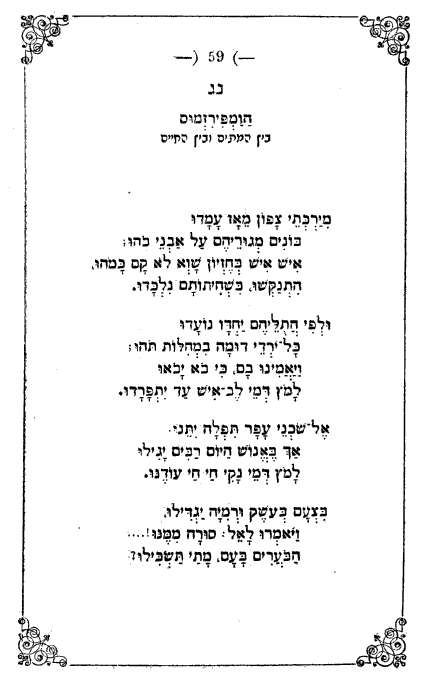
People, in his time primarily Chassidim, who wear Rabbenu Tam tefillin:
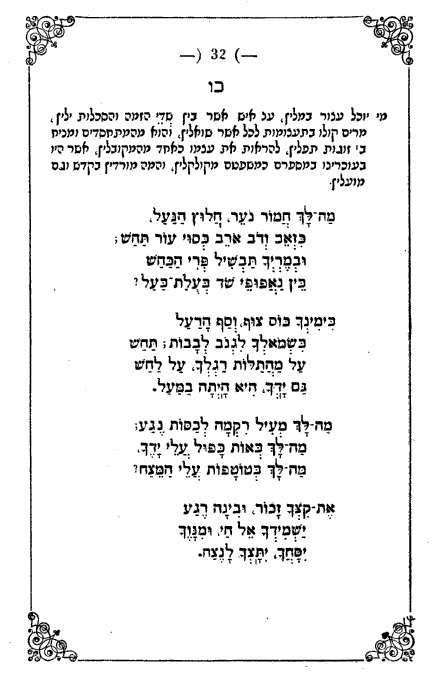
An ode to cigarettes:
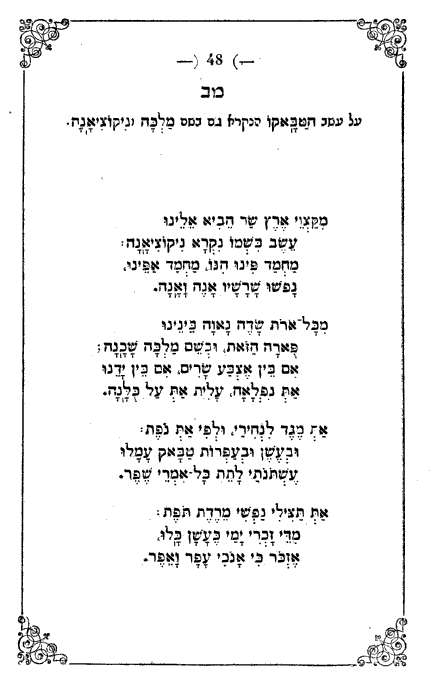
See here for more about Almanzi.
Sunday, December 12, 2010
Yeshiva bochurim in Radin: "Feed us, or we won't learn." JTA 12/29/1933
Talmudic Scholars at Radin Yeshiva on Strike for Food
Dateline: Warsaw
A unique strike was declared here today by the students of the Radin Yeshiva, a Jewish theological seminary.
The students announced that they would refrain from participation in Talmud study, the chief occupation at the Yeshiva, so long as they are not provided with food.
The Radin Yeshiva was founded by the late "Chofetz Chaim", aged Jewish scholar and sage who died a short time ago. Since his death officials in charge of the Yeshiva have been unable to provide the students with food. As long as the "Chofetz Chaim" was alive, his enormous prestige among orthodox Jews and the world-wide recognition of his saintly character brought heavy contributions to the Yeshiva, which appear to have stopped on his death.
"Awed by Ban, Thief Returns the Torah" JTA story, 1922.
That the threat to place a person under the rabbinical ban may sometimes prove effective is shown by the restoration at Bialostock of the Sefer Torah stolen from Krochmal synagogue. The rabbis announced that they would pronounce a "cherem" on the thief if the scroll was not promptly returned to the synagogue on the following day. Botices were posted at conspicuous places. The next day the scroll was found in the corridor of the Beth Midrash.
Friday, December 10, 2010
A rarely seen portrait of the Beis Halevi.

Thursday, December 09, 2010
Deploring the excavation of an ancient Jerusalem tomb in 1863.
The mid-19th century archaeological assumption about the site was that it was the tomb of several of the kings of Judah. Apparently this was because the tomb is so striking, and was known in Arabic as the tomb of kings. As it happens, with some irony perhaps, the Kalba Savua tradition, which is late and based on the teaching of Rabbi Isaac Luria, the Ari, is closer to the truth about this site, which is that it is not the tomb of kings of Judah, but it is indeed the tomb of another notable 1st century Jew. Queen Helena of Adiabene is also remembered fondly in Jewish tradition, but apparently her tomb was not, although anyone reading Josephus ought to have been able to realize that this was her tomb. Interestingly, in the Artscroll book "History of the Jewish people: the Second Temple Era" by Hersh Goldwurm and Yekutiel Friedner the tomb is identified as belonging to Helena and not Kalba Savua (p. 204).
Here is a 19th century drawing of this site:

When de Saulcy began excavating the site in late 1863, with permission from the Ottoman authorities, the Jerusalemite Jews were outraged at the desecration of a venerated tomb. What exactly occurred cannot be known, since both accounts differ, but archaeologists were interested in things, not bones. So de Saulcy scraped the place clean of sarcophogi and the angry Jews reburied the bones.
The November 19, 1863 issue of the Levanon, which can be somewhat anachronistically be called Chareidi in orientation published an article about the incident. The following issue, December 18, 1863 featured a follow-up. Both are at the end of this post.
One of the more famous 19th century Eretz Yisrael emissaries was Rabbi Chaim Zvi Schneersohn (Chayim Zvee Sneersohn), a great-grandson of R. Schneur Zalman of Liadi (hence the surname). Knowing English quite well - he eventually acquired American citizenship - he penned the following letter describing the outrage to London's Jewish Chronicle, date 15 Tevet 5664 (December 15, 1863). Most interestingly, he mentions that he sent a separate letter to London, declining to sign another letter because of some signatories, who were "unbecoming figures." Seeing their signatures made him laugh, although the content of the letter made him cry. It would be interesting to know who these figures were and what sort of internal Jerusalem Jewish politics made him decline to sign a letter alongside these "unbecoming figures."

Here is what Sneersohn looked like:
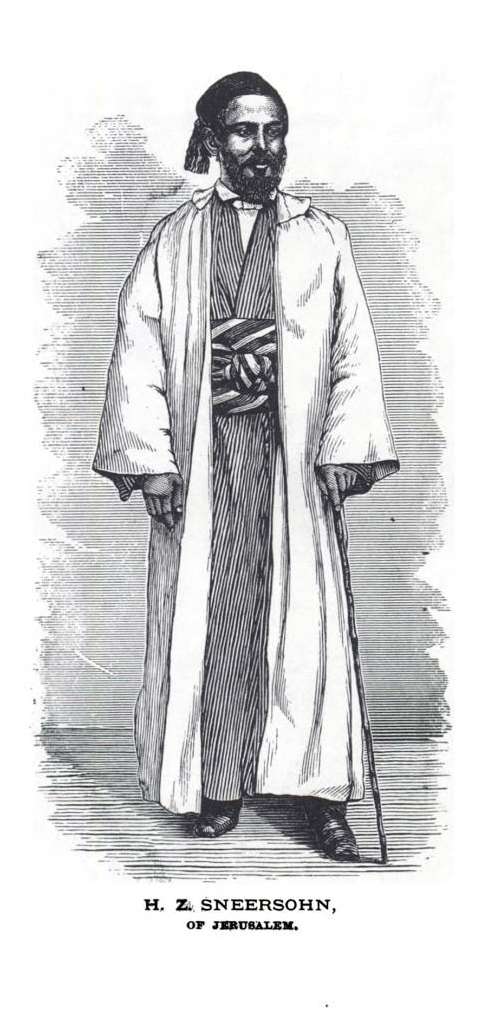
Tuesday, December 07, 2010
A Jewish boy makes an offer of protection in Hebrew in 1839.

Reminds me of a passage or two in Rory Stewart's The Places in Between, although that took place in Afghanistan in early 2002.
Friday, December 03, 2010
Lighting Chanukah candles according to Minhag America.
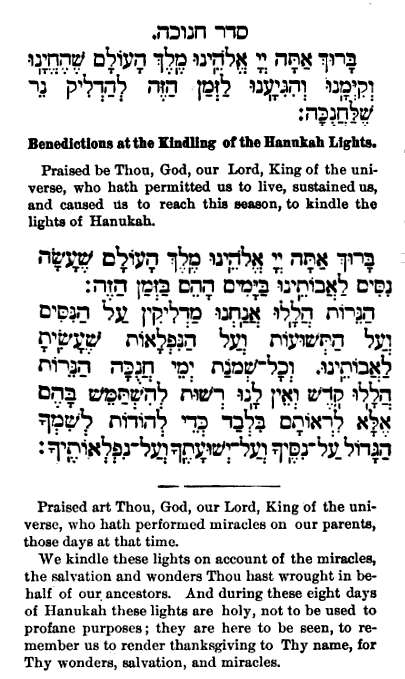
The first and third blessing are combined into one, with certain ideological omissions from the first. The objection is to the traditional formula's, invoking God's "command" of the act about to be performed - in this case, a practice ordained by the rabbis. Since there is nothing for the words "to kindle the lights of Hanukah" to hang on, the Shehecheyanu blessing is compounded to produce a new blessing.
This specific issue is addressed most cogently in Emanuel Schreiber's Reformed Judaism and its pioneers: A contribution to its history (1892) in his section on Gotthold Salomon. The quote below references a sermon the latter delivered in 1846:

Back to Minhag America - The major change in the הנרות הללו recitation is the omission of the reference to the role of כהניך הקדושים, God's sacred priests. Naturally the piyut מעוז צור is omitted entirely.
Thursday, December 02, 2010
An 18th century Chanukah pastime - going to the opera.
These takkanos were originally written in Hebrew and Judeo-German, but translated and printed in Mitteilungen zur jüdischen Volkskunde by Max Grunwald (it includes the regulations from 1715 and 1726). Below is this specific communal regulation, and several other interesting ones:

#5 says that before the repetition of the Shemone Esre prayer, employees of the synagogue must announce that everyone should remain quiet, and on Shabbat and Yom Tov it should be announced before the Torah reading.
#33 says that once a boy reaches age 13 (bar mitzvah) then he may appear in synagogue wearing a black hat.
#34, which includes the opera regulation I began the post with, says in full that both males and females may not visit taverns on Shabbat or holidays to drink. They also may not visit fencing schools (competitions?) or comedy shows on these days, under threat of a 4 Reichsthaler penalty. Everyone is forbidden to go to the opera entirely, except for the week of Purim and during Chanukah. Anyone who violates these regulations will be subject to the penalties, regardless of who they are, and if they are a communal elder, they will lose their position.
Good to know that both men and women are forbidden from going to the tavern to drink on Shabbos. And no opera, ever - except for Chanukah and Purim! Sort of puts the socio-religious situation in perspective.
Some of these communal takkanos are very era-specific. For example, this one forbade women and girls from applying artificial beauty marks on the face, except on their temple:

In 1754 the communal takkanos of Fürth (ק"ק פיורדא) from 1728 were published in German in a book called the Tekunnos Büchlein:
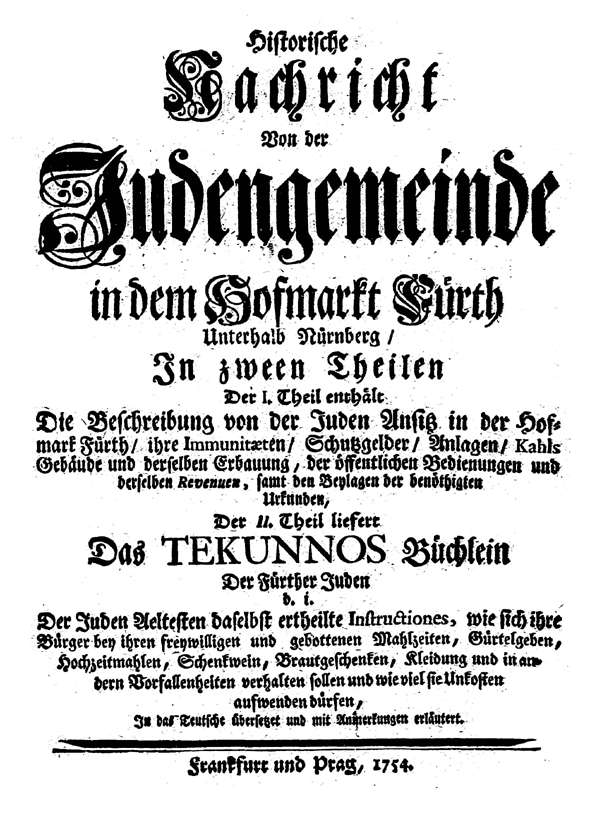
Here we see among other things that wearing a powdered wig to shul was forbidden (for men). It points out that the old, pious men have the decency not to wear their powdered wigs to shul, but not the young men:

And for women, we see that short pinafores, facial beauty marks, and learning to dance were forbidden.

Wednesday, December 01, 2010
Confusing Maharam Ash with Meir Ish Shalom, or, Did Solomon Schechter's teacher ever sermonize against rabbis who speak German instead of Yiddish?
Paul Mendes-Flohr and Jehuda Reinharz's monumental work The Jew in the modern world: a documentary History is an incredible 700+ page sourcebook of various documents relating to modernity. Some, like "the Jew Bill" of 1753 are already in English, but many others are translated from Hebrew, German, French, Italian, etc. It is an incredible mix of highly interesting material, a sermon by R. Ezekiel Landau, a responsum by R. Moses Sofer, pro and con Reform polemics, learned material and legal material and much much more. But everyone makes mistakes.
Below is the section titled An Ultra-Orthodox Position, which is basically a translation of a footnote and some other parts in R. Akiva Joseph Schlesinger's Lev Ha-ivri (1864). The Lev Ha-ivri is a 100 page commentary on the ethical will of the Chasam Sofer, which is kind of wild, if you think about it - I mean, the Chasam Sofer thought that three or four paragraphs was enough to convey his deepest religious emotions to his family. In this book 5 or 6 words can generate a densely packed page filled with many hundreds of words of commentary, and a lengthy footnote or two.
I'll summarize the piece, since not everyone will want to read it. A learned and pious rabbi who preached his sermons in German was hired. Maharam A"sch (Eisenstadter) said that to think this is to follow the Yetzer Horah. Today they appointed a learned, pious rabbi who preaches in German, but next they'll hire someone who speaks German, but isn't learned or pious. Eventually they'll hire a gentile. And the story gets far more heated.
Here it is in the original:

and in The Jew in the modern world: a documentary History:
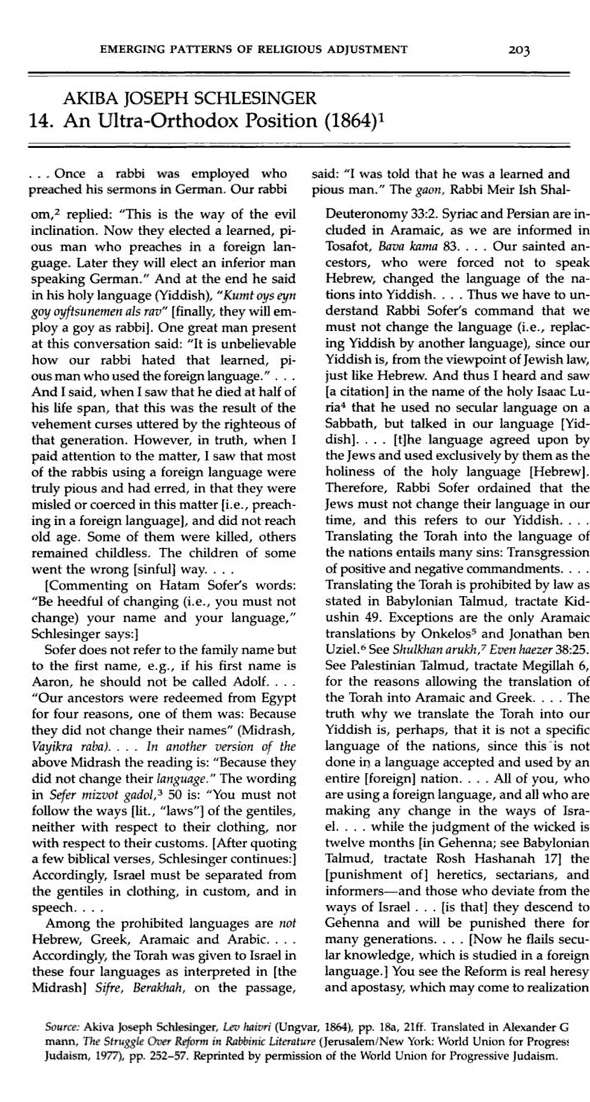

Here's what happened. I was looking for something relating to Targum, and a search of the term "we translate" resulted in this very entry. So I started reading, and as you can see, the text says "the gaon, Rabbi Meir Ish Shalom." My very first reaction was "Huh?" - because Rabbi Meir Ish Shalom was a critical scholar, co-head of the Vienna Beis Midrash with Isaac Hirsch Weiss and the primary teacher of Solomon Schechter. Then in about two seconds I quickly thought "Oh, wait. There must have been another Rabbi Meir Ish Shalom." Then I thought, hold on, it probably says "A"sh" (ie, Aleph"Shin"). And then I thought, wait, so that's Maharam Ash, Rabbi Meir Eisenstadt. Then I looked in the footnote and it reads "Rabbi Meir Ish-Shalom (Friedman: 1831-1908) was a rabbinic scholar who published highly acclaimed critical editions of midrashic and aggadic works."
So what indeed happened was the the acronym was misunderstood, and not only was it misinterpreted but it wasn't enough to assume it was some Ultra-Orthodox Rabbi Meir Ish Shalom-the wrong man (indeed, one who never lived), but at least it would make sense - but the text assumed it was Schechter's teacher, depicted below:
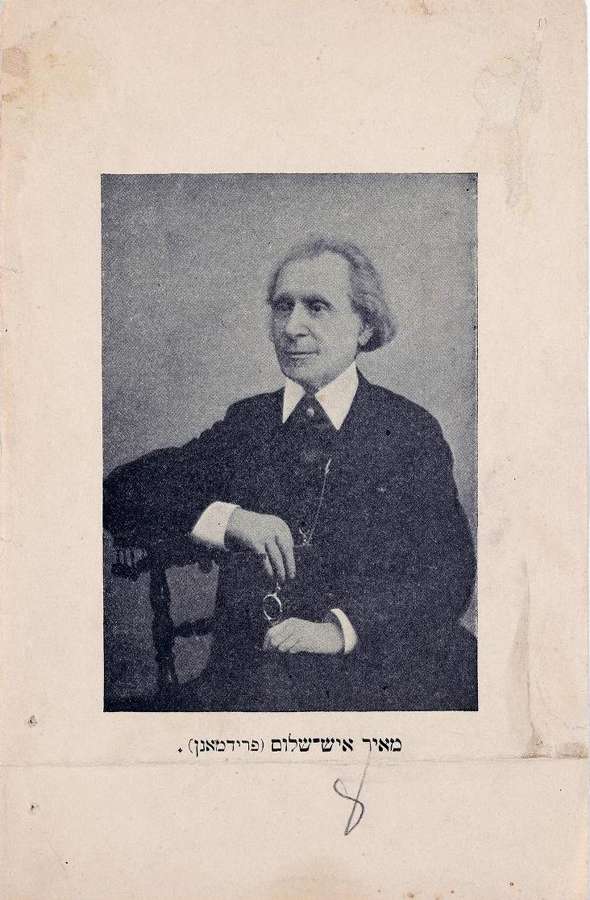
Quite amazing. In fact, what happened was this was someone else's mistake and this book just passed it on. The footnote says that the source is Alexander Guttmann's The Struggle Over Reform in Rabbinic Literature During the Last Century and a Half (New York, 1977) pp. 252-57. I haven't seen that book, but snippets are viewable on Google Books:
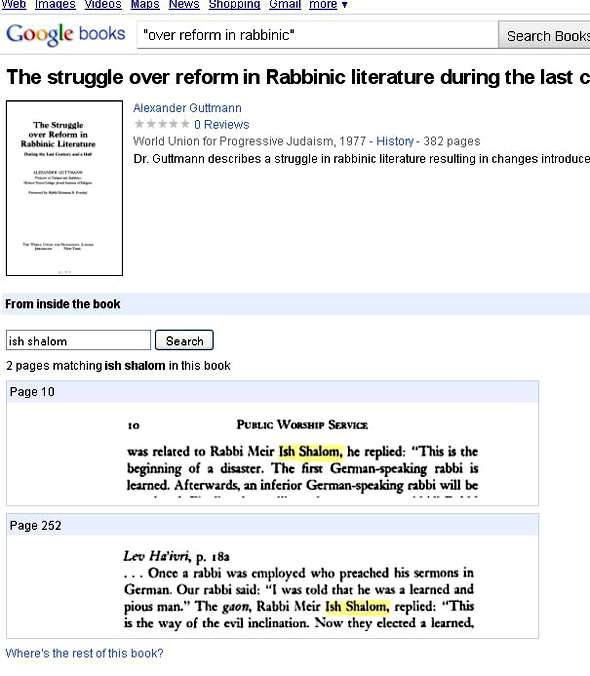
It cannot be stressed enough: everyone makes mistakes. It's a pity I have to even say that. Nevertheless mistakes can often be cleared up just by checking. One gets the sense that in compiling The Jew in the modern world no one bothered to even look at the original, to say nothing of how the rabbi in that footnote (who is even more vehement and stringent than the Chasam Sofer on the issue!) was confused with Meir Ish-Shalom.
Monday, November 29, 2010
Should grammatically challenged writers make digs at grammatically challenged writers? An ironic sentence in an 1882 review of a "Chareidi" journal.
When it came to the Hungarian organ of the Ultra-Orthodox, the מחזיקי הדת, (which you can read here) he writes that it "amuses its readers with Kabbalistic hyperbole and ungrammatical Hebrew." Ironically, he adds that "the journal has existed since four years."

You can read more about the Machzikei Hadas newspaper here.
Interestingly, Gersoni is one of the first to write in English about the legendary Count Valentin Potocki in his sketch called The Converted Nobleman; a Historical Narrative. Not only that, he apparently is the one to supply a first name, as in no earlier account - whether in Polish or in English or in Hebrew - is Potocki's first name mentioned. His account will be analyzed, with some further information about the legendary Graf Walentyn Potocki, or Avraham ben Avraham Ger Zedek, martyr of Ilya or Vilna, in a future post soon.
Here is his entire article on "Periodicals in the Hebrew Tongue:"






